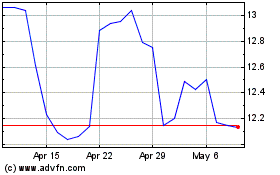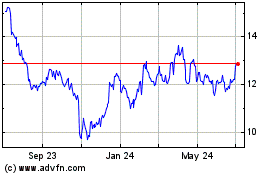Ford Nixes Dividend, Suspends Guidance -- Update
March 19 2020 - 11:30AM
Dow Jones News
By Matt Grossman and Mike Colias
Ford Motor Co. said Thursday it would shore up its balance sheet
by drawing on credit lines and suspending dividends as the Covid-19
pandemic roils the economy.
The company also withdrew its guidance for 2020 issued in early
February, citing economic uncertainty. Ford had guided for adjusted
earnings per share of 94 cents to $1.20.
The automobile giant told its lenders that it will draw down the
entirety of two lines of credit, including $13.4 billion from a
corporate credit facility and $2 billion from a supplemental
facility. Ford also suspended its dividend, a move aimed to improve
financial flexibility in the short term, it said.
The dividend suspension could save the company roughly $2.4
billion annually.
"While we obviously didn't foresee the coronavirus pandemic, we
have maintained a strong balance sheet and ample liquidity so that
we could weather economic uncertainty and continue to invest in our
future," Jim Hackett, Ford's chief executive, said in a
statement.
Ford also unveiled a plan to relieve customers of payments on
some new cars. For buyers of 2019 and 2020 model-year vehicles, the
company said it will cancel three months' worth of payments and
would defer three additional months.
Ford last suspended its dividend in 2007, ahead of the financial
crisis, during which it narrowly avoided bankruptcy. It restored
its dividend in 2012.
Ford's decision Wednesday t o temporarily close all its
factories in North America through at least March 30 will have an
immediate impact on its cash flow and bottom line, because car
makers book revenue as soon as they ship vehicles from the plant to
the dealership.
The company relies on the North America market and its in-house
lending arm for virtually all of its global profit, having swung to
losses overseas. A protracted shutdown of its plants in the U.S.,
Canada and Mexico would have a severe impact on its cash flow and
operating profit, analysts say. The company also has suspended some
production in Europe.
The company is in the midst of an $11 billion, multiyear
restructuring that has crimped its cash flow, which already had
been dwindling in recent years. Company executives have said the
dividend is being funded from cash on the balance sheet, rather
than cash flow, but had planned to continue paying it.
"We like to return value to shareholders," Mr. Hackett said
during a conference call with analysts in February. "The dividend's
been a legendary value creator at Ford...I want to continue
that."
Ford shares fell about 4% in morning trading Thursday. This year
the stock has fallen 52% through Wednesday's close.
Ford's balance sheet is in far better shape than it was heading
into the last downturn, when the then-cash-strapped auto maker
mortgaged factories, office buildings and even its iconic blue oval
trademark to provide a cash cushion to weather the recession. Last
year, Ford had $22 billion in cash and total liquidity of $35
billion, the company said.
Still, the economic fallout from the widening pandemic has
prompted auto analysts to scrutinize auto makers' balance sheets to
determine how well prepared companies are to handle a severe drop
in production.
Credit Suisse analyst Dan Levy said Thursday that Ford's
dividend cut helps to leave the auto maker with "likely ample
liquidity at moment," although he noted the company is still at
risk of an investment downgrade, which would raise Ford's borrowing
costs. Moody's Investors Service cut Ford's rating to junk status
last year, though it still has investment-grade ratings from
Standard & Poor's and Fitch Ratings.
As Ford's share has dropped in recent years, the company's
dividend yield has climbed, rising to over 13% at Wednesday's close
and giving investors a reason to hold on to the stock.
The Ford family, which controls 40% of the company's voting
shares, through ownership of all of its Class B stock, is also a
big beneficiary of the dividend payouts.
Mr. Hackett has been fending off questions about the pace of his
plan to reverse a yearslong profit decline. Ford has missed Wall
Street earnings forecasts in three of the past five quarters,
battering shares even before the recent coronavirus-driven
selloff.
The forecast for pretax profit and free cash flow Ford outlined
to investors last month didn't factor in the potential coronavirus
impact. And still, it disappointed investors.
The company had expected pretax profit of $5.6 billion to $6.6
billion, compared with $6.38 billion last year. It forecast
adjusted free cash flow of $2.4 billion to $3.4 billion, although
some of that was expected to be siphoned off to pay for
restructuring in Europe and South America.
Mr. Hackett said in February the company has redoubled its focus
on generating free cash flow, including tying it more closely to
executives' incentive plans.
Write to Mike Colias at Mike.Colias@wsj.com
(END) Dow Jones Newswires
March 19, 2020 11:15 ET (15:15 GMT)
Copyright (c) 2020 Dow Jones & Company, Inc.
Ford Motor (NYSE:F)
Historical Stock Chart
From Mar 2024 to Apr 2024

Ford Motor (NYSE:F)
Historical Stock Chart
From Apr 2023 to Apr 2024
